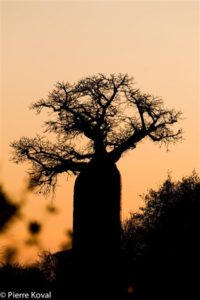Midwest environment:
Between Majunga and Morondava
The great Malagasy Midwest stretches from Morondava in the south until mach Majunga at 
Thus, remarkable limestone or basalt plateaus extend - the Kelifely north of the Bongolava and those of the Bemaraha north of the Tsiribihina (with their great tsingy, for example) - east of the coastal plains, where the deltas of the great rivers (Sofia, Betsiboka, Mahavavy, Manambolo, Tsiribihina and Morondava ) and some large Mangroves-tidal flats interrupt a series of beautiful, from Coral reefs protected beaches.
A dry season of more than seven months and low rainfall (often less than 1 m/year) explain why population density rarely exceeds 10 inhabitants per square kilometer.
The Sakalava Land
As the name suggests (the "Land of Long Valleys"), the Sakalava people settled mainly along the rivers and formed two great kingdoms: the menabe in the 16th century and the boina At the end of the 17th century, its most famous dynasty, originally from the East, the Maroserana ("many ports"), derived its power from the development of livestock, international trade and the slave trade.
The Sakalava threatened the kingdoms of the highlands until Imerina achieved political unification in the early 19th century. The new kingdom gradually weakened its Sakalava rival by pursuing a dual strategy of conquests and alliances.
The Sakalava had strong political institutions, some of which, such as the Fitampoha and Tromba, survived in other forms, and history has recorded the names of several of their rulers a
The Fitampoha is a religious event on the west coast of Madagascar.
It is about a sacred ceremony called reliquary bath, where the relics of the ancient kings of the region are placed in the Tsiribihina River be bathed.
It is one of the most respectful rites and define themselves as the royal Relic bath.
Normally it is celebrated every 5 years. For the Sakalava, as well as for all the other regions in their event, it is the moment to show their gratitude to the ancestors and the long line of kings that succeed each other.
A region dedicated mainly to zebu breeding
In this country, where migrants from the south and the highlands are now very numerous, the plateaus remain the domain of livestock and the much more populated valleys the domain of traditional crops (cassava, corn, sweet potatoes, rice).
However, the development of hydro-agriculture has not been able to replace the development of sugarcane cultivation (Morondava, Namakia), cotton and rice cultivation (Marovoay) enables.
Mahajanga (more than 100,000 inhabitants), the island's second port, has developed into an important industrial, commercial and university city, while Morondava (30,000 inhabitants) is undergoing a strong expansion and aspires to become an important tourist center.
The West, also shaped by Indians
"Throughout western Madagascar, the community of. Karana (collective name for immigrants from India and from Pakistan)-Inder ubiquitous: Majunga, Indian city!
In the Malagasy mentality, the word Karana means the other, the different and suspicious, the one who must be excluded.
It is a generally pejorative, even aggressive term, the karana are often influential and wealthy merchants and entrepreneurs.
In Madagascar, the term Karana broadly refers to all inhabitants of northwest India, the region known as Gujarat.
In reality, the Karana are divided into 6 different socio-religious groups.
- Three groups of Shiite Muslims
- Two groups of Sunni Muslims
- The Banians, Hindu religion.
It seems that on the island the term Karana is essentially used for Muslim Indians of the Shiite faith (probably because they are in the majority).
It is not known exactly where the word "karana" comes from. We are reduced to making hypotheses. Here are four ways of research:
- The Hindi word Karani or Kirani was commonly used to refer to secretaries in Bengal, 
- karana" was also the name of a mixed caste among the Hindus. The secretaries and accountants were actually recruited from these two populations;
- "Certain etymologies found in the Indian Ocean bring the word Karana, formerly written Karany, from the Arabic word Koran, which means reading and subsequently Koran;
- In the last century, Gujerati custom used the term karianjee or karany to refer to one of the three persons in charge of Indian merchant ships: in addition to the malam, captain, pilot, who is responsible for navigation, and the tandel, head of crew and stewardship, who officiates - the karany, who is responsible for cargo and its entry and exit registers.
Deep water ports
Like Morondava, Mahajanga (Majunga), although the second largest port on the island, is not able to accommodate cargo ships at the quay.
The Majunga port or Port aux Boutres, Madagascar's second commercial port and first port on the west coast, Mahajanga is the center of coastal shipping along the west coast.
Fishing, is the main activity of the port, especially important in relation to shrimp, known as pink gold.
This is the place where the first Indians established their trading posts, and since then the activity of the port has only increased, offering an incessant ballet of cargo ships, sailing vessels, schooners and freighters.
The lively wharves full of fruits, vegetables and handicrafts, full of colors and smells, reveal the importance of the port activities.

Transhipments are done on the backs of men, and an army of dockworkers is constantly moving back and forth between the holds of the ships and the depots.
The imposing schooners of traditional construction display their wooden pulleys, natural fiber ropes and cotton sails, often mended and carried by the sun and the tobacco winds of the "Varatraza" (strong wind in the region).
These buildings seem to be straight out of another era, yet dhows and schooners are still widely used throughout Madagascar's west coast.
Many areas of Madagascar are much easier to reach by boat than by inaccessible dirt roads.
All the wharves, which were built at great expense in the 1930s, withstood the silting of the Betsiboka River not withstand. The necessary transshipment by barge therefore restricts traffic.
















